Sanding means smoothing the surface of something by rubbing it with sandpaper. Smooth surfaces are key to a successful paint job, so sanding is an important step in preparing wood for painting. Wood preparation for painting also includes removing old paint, which may require a different type of sandpaper.
If you have a wood surface and you want to paint it, you’ll need to prep it first by sanding it. This makes it easier for the new paint to adhere evenly. It also helps to remove debris, nicks, and splinters. But what type of sandpaper should you use on wood before painting it?
If you want to sand the wood before painting, you should keep in mind what type of sandpaper works best. In this article, we will guide you on the different types of sandpaper and how to use them. So don’t wait any longer, and let’s start.
Types of Sandpaper You Can Use on Wood:
There is a range of different sandpaper types available on the market, each with its own advantages and disadvantages. The type of sandpaper you use will depend on the wood surface you’re working with, as well as the desired finish. Here are 10 types of sandpaper that you can use on wood:
1. Coarse sandpaper (grits 40-60):
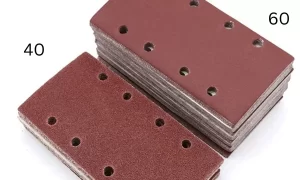
Coarse means that the paper has large abrasive particles. The word coarse in this context means that sandpaper has large particles. This type of sandpaper is good for removing paint or varnish from wood surfaces quickly.
Coarse sandpaper is best used on surfaces that are already smooth since the large particles can damage rough surfaces. When the rough surface is damaged, it will be difficult to repair. If you’re working correctly, you can use coarse sandpaper to remove paint quickly without damaging the wood.
It is an ideal choice for both carpentry and woodworking projects because both project types require a smooth finish. and coarse sandpaper can help you achieve that. So next time you’re working on a wooden surface, make sure to reach for the coarse sandpaper – your projects will thank you for it.
2. Medium sandpaper (grits 80-120):
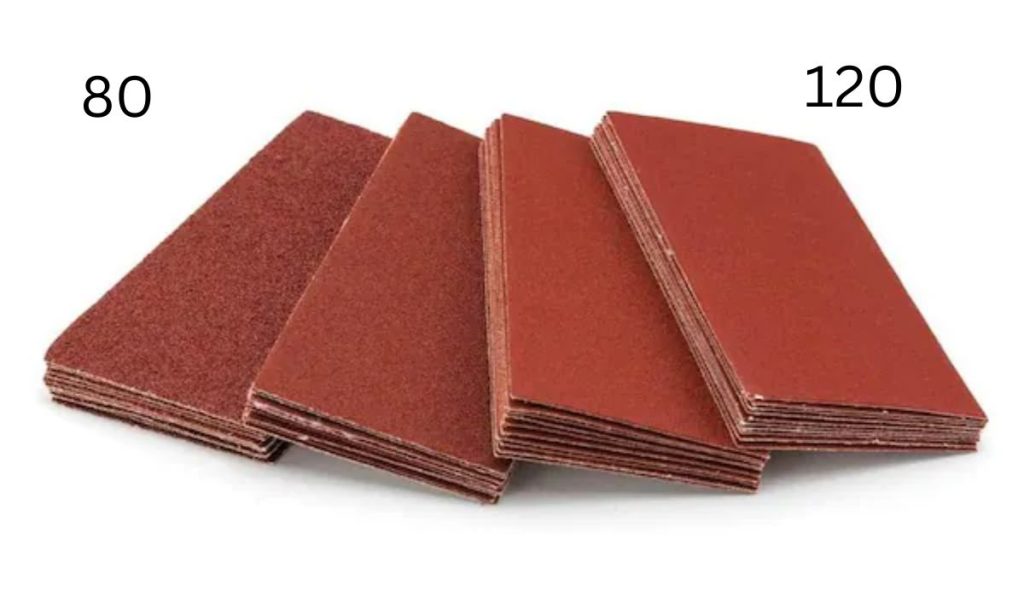
Medium sandpaper has medium-sized particles. so the medium size of the particles is good for removing paint or varnish from wood surfaces quickly. The grits range from 80 to 120, making it tough enough to remove scratches and unevenness but not so rough that it will damage the wood.
Plus, the medium-sized particles offer a happy medium between the large particles of coarse sandpaper and the small particles of fine sandpaper. So this is good all-purpose sandpaper that you can use for a variety of projects.
So next time you’re tackling a wood sanding project, be sure to reach for the medium grit sandpaper – you’ll be glad you did!
3. Fine sandpaper (grits 150-180):
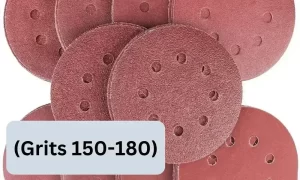
Just like other types of sandpaper, fine sandpaper has its own unique advantages. The little grits make it perfect for taking care of pesky particles on the wood surface without damaging the material. Pesky particles are small pieces of dirt or debris that can be difficult to remove.
The grit size also makes it ideal for light sanding between coats of paint. When you’re painting a wood surface, you need to make sure the surface is smooth before applying the next coat. That’s where fine sandpaper comes in – just give the surface a quick means to ensure a smooth finish.
You can use it on both soft and hardwoods. so both the soft and hardwoods can be sanded with little effort. However fine sandpaper is expensive, but it’s worth the investment because you can use it on a variety of surfaces.
4. Extra Fine sandpaper (grits 220-240):
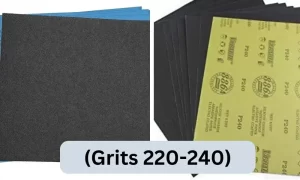
If you are In search of the perfect sandpaper for your next woodworking project? Look no further than extra fine sandpaper! This type of sandpaper is available in a range of grits, from 220 to 240, making it perfect for projects that require an even finish.
The small particles of the extra fine sandpaper make it ideal for removing scratches and other imperfections from the wood surface. imperfection in woodworking can create an uneven finish. and that’s the last thing you want when you’re trying to achieve a professional look.
Plus, the extra fine particles create less dust than other types of sandpaper, meaning you’ll be able to work more efficiently and with less cleanup. So next time you’re starting a new woodworking project, be sure to grab some extra fine sandpaper and get ready for a smoother, easier experience from start to finish.
Tips for Choosing the Right Sandpaper:
Now that you know the different types of sandpaper available, it’s time to learn how to choose the right one for your project. With so many options on the market, it can be tough to decide which grit and type of sandpaper are best for your needs. But don’t worry – we’ve got you covered.
Here are five tips to help you choose the right sandpaper:
1. Consider the type of wood you’re working with:
The type of wood you’re working with will have a big impact on which sandpaper you should use. because different woods have different porosities. and porosities are tiny holes in the wood that can affect how sandpaper works.
If you’re working with softwood, like pine, you’ll want to use coarse grit sandpaper to avoid damaging the surface. The pine has softer grain and the coarser sandpaper is ideal for working with the soft grain without damaging it.
On the other hand, if you’re working with hardwood, like maple, you can use finer grit sandpaper. The hardwood is more durable and can withstand more abrasive sanding. Fine-grit sandpaper is perfect for working with hard grain without damaging the surface.
2. Think about the finish you’re going for:
When you’re working on a wood project, it’s important to think about the finish you’re going for. The type of finish will dictate which sandpaper you should use. and the finish gives you smoothness.
If you’re looking for it will also play a role in deciding the type of sandpaper to use. You’ll want to take into account what finish you want when making your decision.
3. Consider the size of the project:
The size of your project will also impact which sandpaper you should use. If you’re working on a small project, like a jewelry box, you can get away with using finer grit sandpaper. Your small project doesn’t require as much sanding.
But if you’re working on a large project, like a dresser, you’ll want to use coarse grit sandpaper to save time. Because it will take less time to sand a large surface with coarse-grit sandpaper than with finer-grit sandpaper. So you can move on to the next step in your project more quickly.
4. Choose the right type of paper:
There are two types of sandpaper available – wet/dry sandpaper and regular sandpaper. Choose the right type of paper for your project because each type has its own advantages and disadvantages. So it is important to know which one will work best for your project.
5. Follow the manufacturer’s instructions:
If you’re using sandpaper, it’s important to follow the manufacturer’s instructions. Because each type of sandpaper is different and has its own set of instructions. You’ll want to ensure you’re following the right instructions for your project.
Now that you know the different types of sandpaper available and how to choose the right one for your project. You’re ready to get started on your next woodworking project. Just remember to take your time and sand carefully to achieve the best results.
Frequently Asked Questions:
Yes, you can use sandpaper on wood that has already been painted. However, you’ll want to be careful not to damage the paint job. If possible, it’s best to use finer grit sandpaper to avoid damaging the paint.
Wet/dry sandpaper is designed for use with water, while regular sandpaper can be used with or without water. Wet/dry sandpaper is often more effective than regular sandpaper. Because the water lubricates the surface and prevents the paper from clogging.
Can I use sandpaper on wood that is already stained?
Yes, you can use sandpaper on wood that is already stained. However, you’ll want to be careful not to damage the stain job. If possible, it’s best to use finer grit sandpaper to avoid damaging the stain.
The best way to remove sandpaper from wood is to use a putty knife or a razor blade. Gently insert the putty knife or razor blade under the edge of the sandpaper and lift it off. If the sandpaper is stubborn, you can use a heat gun to soften the adhesive.
Yes, you can use sandpaper on wood that is already waxed. but you’ll want to be careful not to damage the wax job. If possible, it’s best to use finer grit sandpaper to avoid damaging the wax.
The short answer is yes, you can use sandpaper on laminate flooring – but only if you use the right type of sandpaper. If you use the wrong type, you could end up damaging your floor.
Conclusion:
Sandpaper is an important step in painting furniture, but it’s not always easy to know which type of sandpaper to use. We’ve outlined the different types of sandpaper and their uses, as well as five tips for choosing the right sandpaper for your project. Be sure to visit our blog regularly for more helpful tips like this one!

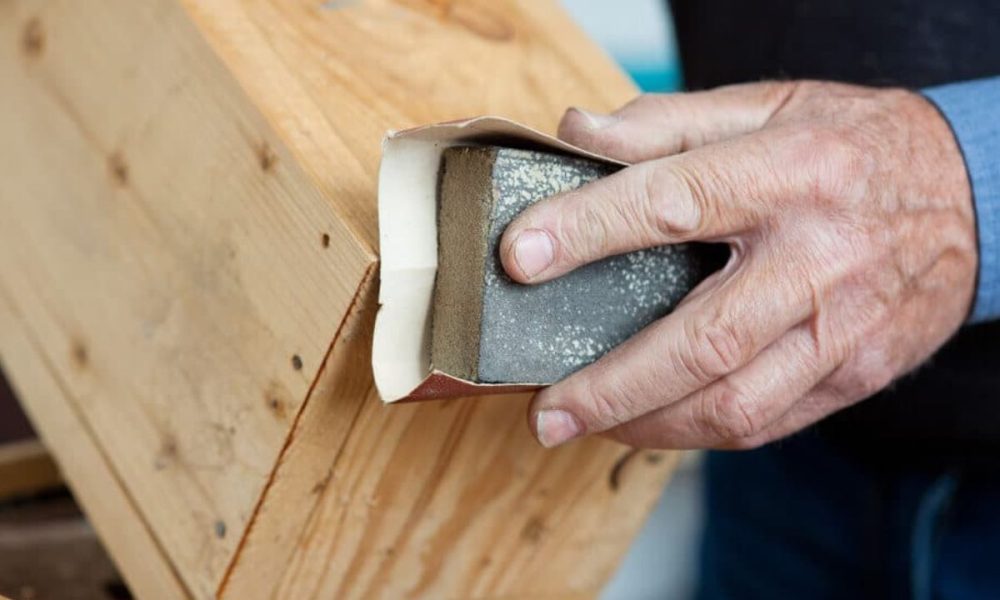
8 thoughts on “What Type of Sandpaper to Use on Wood Before Painting?”
Comments are closed.